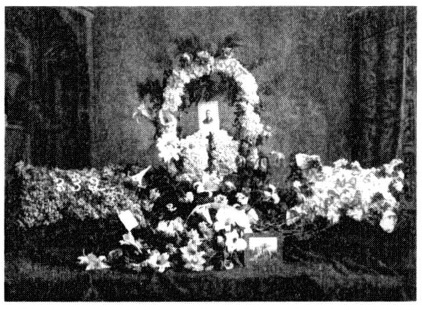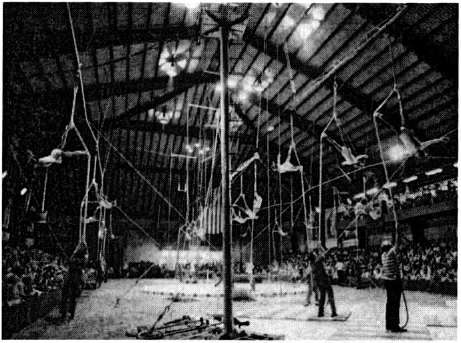The Circus in Winter (31 page)
Read The Circus in Winter Online
Authors: Cathy Day

 
This is a picture of my great-great-uncle's casket. You can just make out a framed photograph of Charlie, the "cause of death," on the funeral display. According to the obituary, the circus band led the funeral procession, "furnishing several appropriate dirges as they passed along Broadway," a very different kind of circus parade observed by "a large concourse of citizens in carriages and on the walks."
 
In the 1960s, the town council asked former circus people who'd retired in Peru to train local kids, and the Circus City Festival was born. Peru's young people spend the spring and summer training very hard, and then, during the third week of July, downtown becomes a carnival midway, and, each night, the kids put on an impressive, very professional circus performance. I'm often asked if I joined the circus, but unfortunately, the answer is no. I certainly could have. The Hodginis (head trainers) lived next door to my grandparents, and their daughter was my babysitter. I spent many afternoons in their backyard, which contained a pool, trampoline, and trapeze bar. All I cared about was the pool. But I never missed the circus. I loved sitting in the stands, watching kids I knew from school and church performing such difficult and amazing feats. And I still enjoy going back to Peru in July (often dragging friends with me) to watch the next generation carry on the tradition. This photograph was taken by the long-time photo editor of the
Peru Daily Tribune,
Tony Hare, and was turned into a postcard, one I've carried around with me for many years. It's a picture of my favorite act, the Spanish Web.
GRATEFUL
acknowledgment is made to the following publications in which some of these stories were first published, in some cases in a slightly different form:
Antioch Review:
"The Last Member of the Boela Tribe"
River Styx:
"The King and His Court"
Story
and
New Stories from the South
(Algonquin Press): "The Circus House"
The Southern Review:
"Wallace Porter" as "Wallace Porter Sees the Elephant"
Shenandoah:
"Jennie Dixianna" as "Jennie Dixianna and the Spin of Death"
American Fiction,
Vol. 10 (New Rivers Press): "Boss Man"
Walking on Water
(University of Alabama Press): "Winnesaw" as "Mississinewa"
A number of books and other historical documents were essential to my writing and research:
The Circus in America
by Charles Philip Fox and Tom Parkinson (Waukesha, Wis.: Country Beautiful, 1969);
The Circus: Lure and Legend
compiled and edited by Mildred Sandison Fenner and Wolcott Fenner (Englewood Cliffs, N.J.: Prentice-Hall, Inc., 1970);
The American Circus: An Illustrated History
by John Culhane (New York: Henry Holt & Company, 1990);
Freaks: Myths and Images of the Secret Self
by Leslie A. Fiedler (New York: Simon & Schuster, 1978);
Pictorial History of the American Circus
by John and Alice Durant (New York: A. S. Barnes & Company, 1957);
Circus Lingo: Written by a Man Who Was There
by Joe McKennon (Sarasota, Fla.: Carnival Publishers, 1980);
Troupers of the Golden Mascot or Tales of the Yellow Wagon Shows
by Louis Wood (Des Moines, Iowa: Kenyon Press, 1904);
Indiana's Big Top
by Don L. Chaffee (Grand Rapids, Mich.: Foremost Press, 1969);
Route Book of the Great Wallace Show, Season 1895
and
Season 1899
(Columbus, Ohio: Nitchske Bros. Press); "Miami County: Coming of the White Pioneers, Their Activities Down to 1885" from
A Pioneer History of Peru and Miami County
by John A. Graham (Peru Republican Printing, 1877);
Slaves in the Family
by Edward Ball (New York: Random House, 1998);
Miami County, Indiana: A Pictorial History
by Marilyn Coppernoll (Virginia Beach, Va.: Donning Company, 1995).
I'd like to thank the curators and staff of the historical museums of Miami and Howard counties in Indiana and the Circus World Museum in Baraboo, Wisconsin, for their kind and generous assistance. My entire family supported me during the writing of this book, especially the generation who lived in Peru back "when the circus came to town" and told me their stories about those days. Special thanks to my great-aunt Margaret Hoffman, for letting me have the bullhook, and my great-uncle Joseph Shrock and my grandmother Mary Wilson, who saved everything and then gave it to me.
I started writing this book in 1991. A great number of people supported me personally and professionally during those years, far too many to name individually, but I'm grateful to all of them nonetheless. Specifically, I'd like to thank my friends who read these stories as I was putting the book together and provided invaluable editorial advice: Liv Bowring, Jo Carney, Chris Ludwig, Nina Ronstadt, and Catie Rosemurgy. I'd like to thank all my teachers, especially Tom Chiarella and Barbara Bean at DePauw University, John Keeble, Tom Rabbitt, and Allen Wier at the University of Alabama, and Tim O'Brien at the Sewanee Writers' Conference. Thanks to my students in Alabama, Minnesota, and New Jersey for their patience and support. For the precious gifts of writing time and financial assistance, I thank Minnesota State University at Mankato, The College of New Jersey, and especially the Bush Foundation, whose generous fellowship allowed me to take a year off from teaching, during which time I wrote and revised most of these stories.
My agent Peter Steinberg has been my devoted champion, along with my editor Ann Patty, fellow Hoosier and circus person. And most importantly, I thank my familyâmy sister Christy, my brother Kenny Scott, and my parents, Kenny and Pattyâfor letting me go where I've needed to go and for always welcoming me back home again to Indiana.
